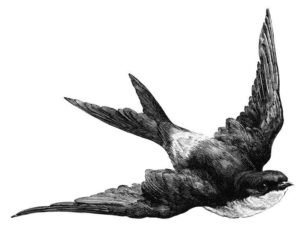 Return of the Barn Swallows
Return of the Barn Swallows
They arrive every year around the second week of May, these beautiful little birds that nest below the Riverfront Café. We first noticed them about twenty years ago, when a guest told me that those crazy birds flying around like a US Fighter Jets were Barn Swallows and they consume hundreds of bugs daily and that is perhaps why we never had a “bug problem”. It is very entertaining watching these tiny birds nose diving in and out and around the café keeping our environment bug-free… nature at work.
The barn swallow (Hirundo rustica) is the most widespread species of swallow in the world. It is a distinctive passerine bird with blue upperparts, a long, deeply forked tail and curved, pointed wings. It is found in Europe, Asia, Africa and the Americas. In Anglophone Europe it is called just the swallow; in Northern Europe, it is the only common species called a “swallow” rather than a “martin”.
There are six subspecies of the barn swallow, which breed across the Northern Hemisphere. Four are strongly migratory, and their wintering grounds cover much of the Southern Hemisphere as far south as central Argentina, the Cape Province of South Africa, and northern Australia. Its huge range means that the barn swallow is not endangered, although there may be local population declines due to specific threats.
The barn swallow is a bird of open country that normally uses man-made structures to breed and consequently has spread with human expansion. It builds a cup nest from mud pellets in barns or similar structures and feeds on insects caught in flight. This species lives in close association with humans, and its insect-eating habits mean that it is tolerated by humans; this acceptance was reinforced in the past by superstitions regarding the bird and its nest. There are frequent cultural references to the barn swallow in literary and religious works due to both its living in close proximity to humans and its annual migration. Interestingly, the barn swallow is the national bird of Austria and Estonia.

